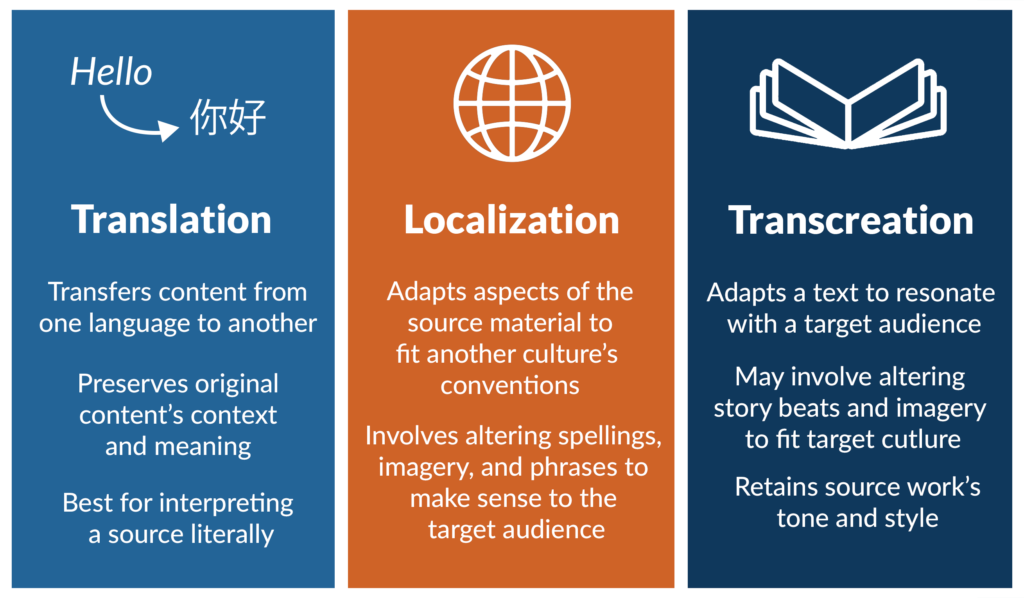Translation, localization, and transcreation services play an important role in our world. These language services are vital in keeping us connected, whether for sharing creative work, launching global marketing campaigns, or informing audiences. But what is the difference between them? Read on to learn more.
What are Translation and Localization Services?

Translation and localization services are distinct yet interconnected disciplines that play a pivotal role in today’s global business landscape. Translation involves converting text or spoken words from one language to another, primarily focusing on linguistic accuracy and the faithful representation of the original text. Localization, on the other hand, is a more nuanced and comprehensive process. It involves adapting not just the language but also the content, images, and even the layout to fit the cultural, social, and legal norms of the target audience. This could mean modifying images to resonate with local culture, adjusting currency symbols, changing date formats, or altering color schemes to align with local preferences. In our increasingly interconnected global economy, these services have become indispensable. They enable businesses to effectively communicate and engage with a diverse customer base, ensuring that the message is linguistically accurate and culturally resonant.
Transcreation vs. Translation
Transcreation is a specialized service that combines elements of translation and creative writing. Unlike standard translation, which is primarily concerned with linguistic accuracy, transcreation aims to capture the original content’s tone, emotion, and cultural context. This often involves creative rewriting and adaptation, making it more akin to copywriting in a different language. Transcreation is especially valuable in advertising, marketing, and public relations, where the emotional engagement of the audience can significantly impact the success of a campaign. It allows businesses to convey their messages in a way that resonates emotionally and culturally with the target audience, thereby increasing the effectiveness of their marketing efforts.
What is the Major Aim of Transcreation?
The overarching goal of transcreation is to produce content that evokes the same emotional and contextual relevance in the target audience as the original does in its native audience. This is crucial for marketing materials, advertisements, and brand messages. The emotional impact often carries as much weight as the information conveyed. Transcreation ensures that your brand’s voice and message remain consistent across different languages and cultural landscapes, enhancing brand recognition and fostering customer loyalty. It’s a strategic approach that goes beyond mere translation, aiming to create a deep emotional connection with the audience.
What Does Transcreation Mean in Translation?
Within the translation industry, transcreation is often viewed as a specialized, high-level skill. It demands a deep understanding of both the source and target languages, as well as their cultural nuances and idioms. Transcreators are usually native speakers of the target language and often have a solid creative writing or journalism background. They collaborate closely with clients to fully grasp the brand’s voice, the core message, and the specific emotional response they aim to elicit from the audience. This collaborative approach ensures that the final product is not merely a translated version of the original but a unique piece of content that can stand on its own in the target language. It’s a meticulous process requiring a unique set of skills and a deep understanding of linguistic and cultural nuances.
When Should You Use Transcreation?
Transcreation is most effective for content rich in cultural references, humor, idioms, or other elements that don’t have a direct translation. It is commonly employed in marketing campaigns, advertisements, and content where maintaining the brand’s unique voice and emotional resonance is paramount. In today’s digital age, where consumer attention spans are increasingly fragmented, transcreation offers a strategic advantage. It allows brands to create content that is not only linguistically accurate but also culturally and emotionally resonant, thereby capturing the hearts and minds of consumers. It’s a specialized service that requires a unique blend of linguistic expertise and creative flair.
What is the Difference Between Translation and Localization Services?
Translation and localization, although closely related, serve different needs. Translation is just one component of the broader localization process, which may involve various other activities. These can include changing the layout of a website to fit local reading patterns, modifying graphics to better resonate with local culture, or even altering some content to comply with local laws, regulations, or customs. As businesses expand their global footprint, understanding the nuanced differences between translation and localization becomes increasingly critical for effective cross-border communication. It’s a complex process requiring a multi-disciplinary approach involving linguists, designers, programmers, and legal experts.
What Companies Need Translation Services?
In today’s globalized world, companies across various industries find themselves in need of translation services. Whether it’s healthcare providers needing to translate medical records, legal firms requiring contract translations, or tech companies translating user manuals, the need is ubiquitous. E-commerce platforms, too, often require translation and localization services to make their websites accessible and user-friendly for a global audience. With the relentless pace of globalization, the demand for these services has skyrocketed. Translation and localization are no longer optional but have become a mandatory investment for companies aiming to compete globally. It’s a critical business function that has far-reaching implications for a company’s success in international markets.
Let’s Get Started
Now that you know the differences between translation, localization, and transcreation, let’s start your next project! With Traduality, you can manage projects, make payments, and communicate with language service providers across the globe all in one place. Create your first project today and find vetted translators, or book a meeting with us to learn more about your specific needs to get started!
Updated 2/21/2024.





0 Comments